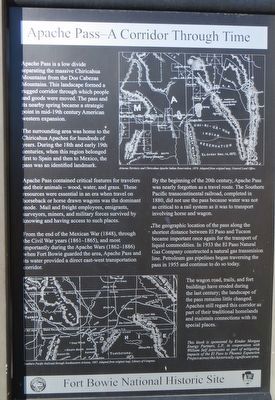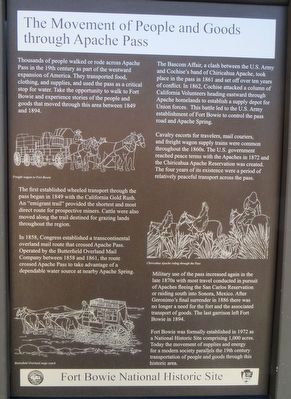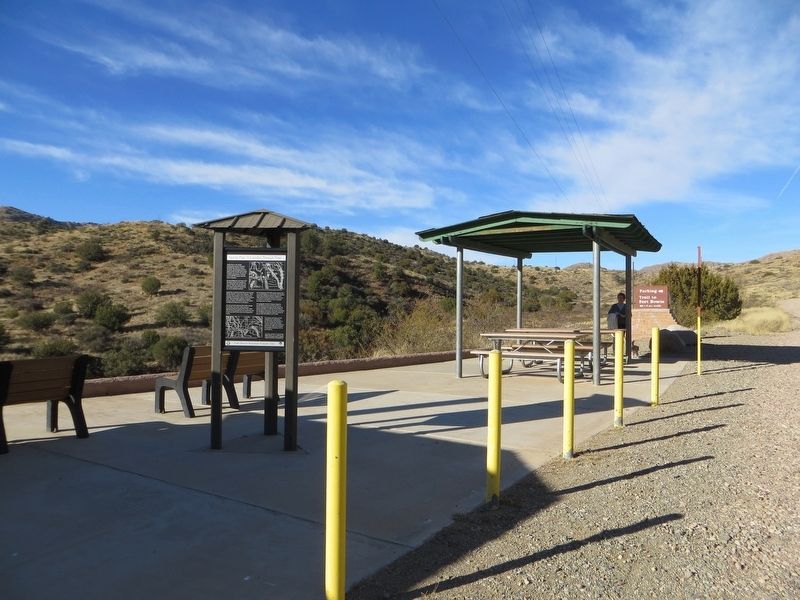Near Bowie in Cochise County, Arizona — The American Mountains (Southwest)
Apache Pass - A Corridor Through Time
Fort Bowie National Historic Site
Apache Pass is a low divide separating the massive Chiricahua Mountains from the Dos Cabezas Mountains. This landscape formed a rugged corridor through which people and goods were moved. The Pass and its nearby spring became a strategic point in mid-19th century American western expansion.
The surrounding area was home to the Chiricahua Apaches for hundreds of years. During the 18th and early 19th centuries, when this region belonged first to Spain and then to Mexico, the pass was an identified landmark.
Apache Pass contained critical features for travelers and their animals – wood, water, and grass. These resources were essential in an era when travel on horseback or horse drawn wagons was the dominant mode. Mail and freight employees, emigrants, surveyors, miners, and military forces survived by knowing and having access to such places.
From the end of the Mexican War (1848), through the Civil War years (1861-1865), and most importantly during the Apache Wars (1862-1886) when Fort Bowie guarded the area, Apache Pass and its water provided a direct east-west transportation corridor. By the beginning of the 20th century, Apache Pass was nearly forgotten as a travel route. The Southern Pacific transcontinental railroad, completed in 1880, did not use the pass because water was not as critical to a rail system as it was to transport involving horse and wagon.
The geographic location of the pass along the shortest distance between El Paso and Tucson became important once again for the transport of liquid commodities. In 1933 the El Paso Natural Gas Company constructed a natural gas transmision line. Petroleum gas pipelines began traversing the pass in 1955 and continue to do so today.
The wagon road, trails, and fort buildings have eroded during the last century; the landscape of the pass remains little changed. Apaches still regard this corridor as part of their traditional homelands and maintain connections with its special places.
Second Marker:
The Movement of People and Goods through Apache Pass
Thousands of people walked or rode across Apache Pass in the 19th century as part of the westward expansion of America. They transported food, clothing, and supplies, and used the pass as a critical stop for water. Take the opportunity to walk to Fort Bowie and experience stories of the people and goods that moved through this area between 1849 and 1894.
The first established wheeled transport through the pass began in 1849 with the California Gold Rush. An “emigrant trail” provided the shortest and most direct route for prospective
miners. Cattle were also moved along the trail destined for grazing lands throughout the region.
in 1858, Congress established a transcontinental overland mail route that crossed Apache Pass. Operated by the Butterfield Overland Mail Company between 1858 and 1861, the route crossed Apache Pass to take advantage of a dependable water source at nearby Apache Spring.
The Bascom Affair, a clash between the U.S. Army and Cochise's band of Chiricahua Apache, took place in the pass in 1861 and set off over ten years of conflict. In 1862, Cochise attacked a column of California Volunteers heading eastward through Apache homelands to establish a supply depot for Union forces. This battle led to the U.S. Army establishment of Fort Bowie to control the pass road and Apache Spring.
Calvary escorts for travelers, mail couriers, and freight wagon supply trains were common throughout the 1860s. The U.S. Government reached peace terms with the Apaches in 1872 and the Chiricahua Apache Reservation was created. The four years of its existence were a period of relatively peaceful transport across the pass.
Military use of the pass increased again in the late 1870s with most travel conducted in pursuit of Apaches fleeing the San Carlos Reservation or raiding south into Sonora, Mexico. After Geronimo's final surrender in 1886 there was no longer a need for the fort and the associated transport of goods. The last garrison left Fort Bowie in 1894.
Fort Bowie was formally established in 1972 as a National Historic Site comprising 1,000 acres. Today the movement of supplies and energy for a modern society parallels the 19th century transportation of people and goods through this historic area.
Erected by Kinder Morgan Energy Partners, L.P. In cooperation with William Self Associates.
Topics. This historical marker is listed in these topic lists: Forts and Castles • War, US Civil • Wars, US Indian. A significant historical year for this entry is 1880.
Location. 32° 9.393′ N, 109° 27.16′ W. Marker is near Bowie, Arizona, in Cochise County. Marker is on Apache Pass Road, 13 miles south of Business Interstate 10, on the left when traveling west. Touch for map. Marker is in this post office area: Bowie AZ 85605, United States of America. Touch for directions.
Other nearby markers. At least 8 other markers are within walking distance of this marker. Mining Cabin (about 400 feet away, measured in a direct line); Parke Camp Site (approx. 0.4 miles away); The Bascom Affair (approx. half a mile away); Bascom-Cochise Meeting Site (approx. 0.6 miles away); The Stage Station Ruin (approx. 0.6 miles away); The Butterfield Overland Mail (approx. 0.6 miles away); Post Cemetery (approx. 0.7 miles away); The Chiricahua Apache Indian Agency (approx. ¾ mile away). Touch for a list and map of all markers in Bowie.
Credits. This page was last revised on January 13, 2017. It was originally submitted on January 13, 2017, by Bill Kirchner of Tucson, Arizona. This page has been viewed 623 times since then and 39 times this year. Photos: 1, 2, 3. submitted on January 13, 2017, by Bill Kirchner of Tucson, Arizona.


